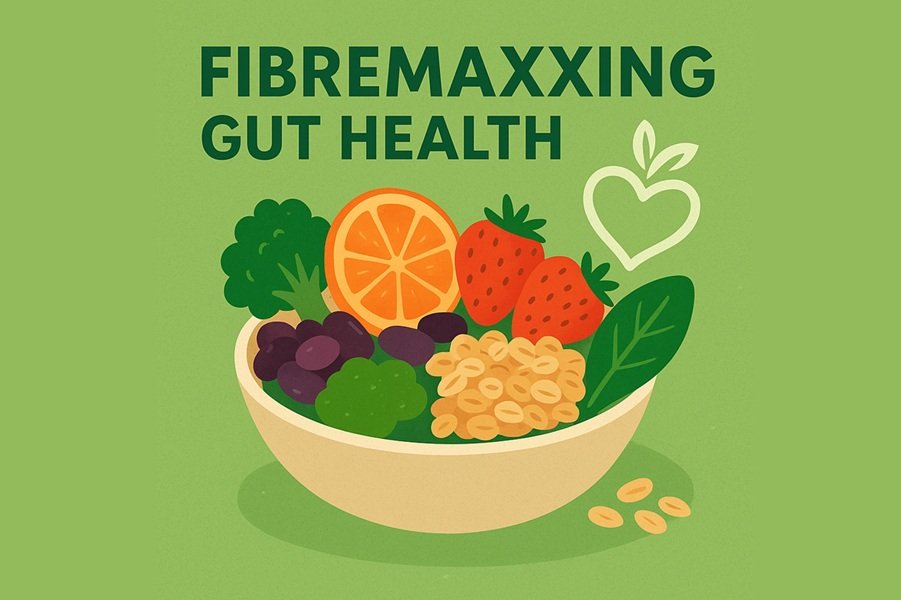
Introduction
In the ever-evolving world of nutrition and wellness, a new buzzword has taken center stage — “Fibremaxxing.” While we’ve all heard about high-protein diets and low-carb lifestyles, the focus is now shifting toward a nutrient that has long been underappreciated: dietary fiber. Fibremaxxing is all about maximizing your fiber intake through strategic food choices and meal planning to improve gut health, metabolism, and overall well-being.
But what exactly does this trend entail, and why are nutritionists and health influencers calling it a “game-changer” for long-term wellness? Let’s break it down.
What Is Fibremaxxing?
Fibremaxxing is a modern dietary approach that emphasizes increasing the intake of high-fiber foods—such as fruits, vegetables, legumes, and whole grains—to optimize digestion, regulate hormones, and enhance the body’s natural detoxification process.
Unlike fad diets that restrict certain food groups, fibremaxxing isn’t about cutting things out—it’s about adding more of the right foods. The term gained popularity through social media and nutrition blogs, where wellness enthusiasts began showcasing creative ways to incorporate more fiber into everyday meals.
The Science Behind Fibremaxxing
Fiber is a type of carbohydrate that the body cannot digest. Instead of breaking down into sugar, it passes through the digestive system relatively intact, helping maintain a healthy gut. There are two primary types of fiber:
- Soluble Fiber: Dissolves in water to form a gel-like substance, helping to lower cholesterol and blood sugar levels. Found in oats, apples, citrus fruits, and beans.
- Insoluble Fiber: Adds bulk to stool and aids in regular bowel movements. Found in whole grains, nuts, and vegetables.
Studies show that adults should consume 25–35 grams of fiber daily, yet the average intake globally remains far below that—often less than 15 grams per day. Fibremaxxing seeks to bridge this nutritional gap.
Why Fibremaxxing Is Trending
- Gut Health Awareness:
The wellness world has shifted toward prioritizing the microbiome—the trillions of bacteria living in our gut. Fiber acts as a prebiotic, feeding beneficial gut bacteria and supporting a balanced microbiome. - Sustainable Weight Management:
High-fiber diets help increase satiety, meaning you feel fuller for longer. This naturally reduces calorie intake without the need for strict dieting. - Metabolic Benefits:
Fiber helps regulate blood sugar levels, preventing energy crashes and reducing the risk of insulin resistance and Type 2 diabetes. - Heart Health:
Soluble fiber can reduce LDL (“bad”) cholesterol, supporting cardiovascular wellness. - Holistic Wellness Appeal:
Fibremaxxing aligns with clean eating, plant-based lifestyles, and the growing interest in functional foods—making it the perfect fit for health-conscious audiences.
How To Practise Fibremaxxing
Fibremaxxing isn’t about supplements—it’s about smart food swaps and whole-food nutrition. Here are some easy strategies to get started:
1. Choose Whole Grains Over Refined Ones
Opt for brown rice, quinoa, oats, and whole wheat bread instead of white rice or refined flour.
2. Add Seeds and Nuts to Your Meals
Chia seeds, flaxseeds, and almonds are fiber powerhouses. Sprinkle them on salads, smoothies, or yogurt.
3. Load Up on Legumes
Include lentils, chickpeas, and beans in your meals for both plant-based protein and fiber.
4. Don’t Peel All Fruits and Vegetables
Much of the fiber in apples, cucumbers, and potatoes lies in the skin—keep it on whenever possible.
5. Try Fibremaxxing Smoothies
Blend leafy greens, berries, oats, and chia seeds for a nutrient-packed drink that supports digestion.
6. Eat More Fermented Foods
Kombucha, kefir, and sauerkraut complement fiber intake by balancing gut bacteria.
Red Flags: Too Much Fiber Can Backfire
While fibremaxxing offers many benefits, overdoing it can cause digestive discomfort, bloating, or nutrient absorption issues. Here’s what to keep in mind:
- Increase Gradually: Jumping from 10 to 30 grams of fiber overnight can shock your system.
- Stay Hydrated: Fiber needs water to move smoothly through your digestive tract.
- Balance Matters: Pair fiber-rich foods with healthy fats and proteins for sustained energy.
Fibremaxxing vs. Traditional Diets
| Aspect | Fibremaxxing | High-Protein / Keto Diets | Low-Carb Diets |
|---|---|---|---|
| Focus | Gut health and fiber intake | Protein intake | Carb restriction |
| Primary Foods | Fruits, veggies, legumes, whole grains | Meats, eggs, dairy | Fats and proteins |
| Weight Loss Mechanism | Satiety through volume and slow digestion | Ketosis and calorie burn | Reduced calorie intake |
| Suitability | Universal | May strain kidneys or limit carbs | Hard to sustain long term |
Expert Insights
Nutrition experts emphasize that fibremaxxing isn’t a quick fix—it’s a long-term approach to sustainable health.
“The beauty of fibremaxxing lies in its simplicity. You don’t need fancy supplements—just real food and consistent habits,” says Dr. Priya Menon, a clinical dietitian.
She adds, “Most lifestyle diseases stem from poor gut health and inflammation. A fiber-focused diet addresses both.”
When to Consult a Doctor or Nutritionist
If you experience persistent bloating, constipation, or stomach pain while increasing fiber intake, it’s best to consult a healthcare provider. People with IBS (Irritable Bowel Syndrome) or Crohn’s disease should follow tailored fiber plans as per medical advice.
Read this: Understanding Vaginal Discharge: What’s Normal and When to Worry
Conclusion
Fibremaxxing is more than just a passing trend—it’s a return to nature’s basics. In a world obsessed with protein shakes and quick fixes, this movement reminds us that long-term health starts in the gut. By embracing whole foods and balancing your plate with plant-based fiber, you can support digestion, immunity, and longevity in one simple, delicious step.
So, next time you plan a meal, ask yourself—are you fibremaxxing yet?






